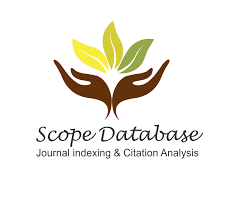Details
Assessment of the Effect of Blue Light on Visual Acuity among College Students
Orjiako Rosemary Ndidiamaka
Department of Human Physiology, Faculty of Basic Medical Sciences, College of Health Sciences, Nnamdi Azikiwe University, Nnewi, Anambra State, Nigeria
Edwin Okechukwu Nwobodo
Department of Human Physiology, Faculty of Basic Medical Sciences, College of Health Sciences, Nnamdi Azikiwe University, Nnewi, Anambra State, Nigeria
Martin Chinedu Onuh
Department of Human Physiology, Faculty of Basic Medical Sciences, College of Health Sciences, Nnamdi Azikiwe University, Nnewi, Anambra State, Nigeria
David Chibuike Ikwuka
Department of Human Physiology, Faculty of Basic Medical Sciences, College of Health Sciences, Nnamdi Azikiwe University, Nnewi, Anambra State, Nigeria
Download PDF http://doi.org/10.37648/ijrst.v13i02.002
http://doi.org/10.37648/ijrst.v13i02.002
Abstract
Visual acuity is the acuteness or clarity of vision which is dependent on the shortness of the retinal focus within the eye, and the sensitivity of the interpretative faculty of the brain. It is expressed as a fraction, such as 20/20 or 6/6 which is the normal visual acuity. Poor or impaired visual acuity is expressed as 20/40 and below or 6/9 and below. Blue light, which is one of the visible rays from the sun and also an artificial constituent of many modern devices, is a source of illumination which among other factors strongly affects our visual acuity. The present rapid, steady advancement in technology has led to a great increase in our usage and exposure to blue light. It is not uncommon nowadays to easily find someone who spends his entire day on digital screen, and many times even a great deal of the nighttime is also spent on blue-light-emitting technologies. The aim of this study is to assess and determine how this blue light affects college students and perhaps their productivity. A descriptive cross-sectional study was conducted using the focus group discussion (FGD) technique amongst 100 college students across five departments in College of Health Sciences, Nnamdi Azikiwe University, Nnewi Campus. The mean age of the respondents was 22.06 years. More of the respondents were females (66%) while 34% were males. The prevalence of visual acuity impairment after a considerably long usage of blue light was 37%. The majority of the respondents (87%) use a light-emitting diode (LED) technology torch/lantern during their night studies. 82% also uses their mobile phones for their studies and other academic works in which they have to spend many hours at once on the screen. Many others are exposed to other sources of blue light, and more even combine usage of different sources of blue light at once. The prevalence of visual acuity status below 6/6 amongst the students was high, and this is worrisome with regards to its long term effects or cumulative effects on their vision. Adequate sensitization on the harmful effects of long exposure to blue lights, usage of blue light filters/glasses (photochromic lens, for instance), taking frequent breaks from digital screens, encouraging outdoor use of blue light screens, early and proper management of impaired vision and more intakes of foods that enhance eyesight are recommended.
Keywords: Visual acuity; Blue light; Visible rays; Light-emitting diode (LED) technology; College students; Photochromic lens
References
- Bahkir, F. A., and Grandee, S. S. (2020). Impact of the COVID-19 lockdown on digital device-related ocular health. Indian journal of ophthalmology, 68(11), 2378-2383.
- Nwosu SNN, Nwobodo EO, Ndulue JK. Vision survey of the Nnamdi Azikiwe University Medical Students. Niger J Ophthalmol. 2016; 24(1): 12-5.
- Patil A., Bhavya, Chaudhury S., Srivastava S. (2019) Eyeing computer vision syndrome: Awareness, knowledge, and its impact on sleep quality among medical students. Ind Psychiatry J. 28:68-74.
- Abdull, M.M, Sivasubramaniam S, Murthy G.V, Gilbert C, Abubakar T, Ezelum C, Rabiu, M.M; (2009) ‘Nigeria National Blindness and Visual Impairment Study Group. Causes of blindness and visual impairment in Nigeria: The Nigeria national blindness and visual impairment survey’. Invest Ophthalmol Vis Sci. Sep;50(9):4114-20.
- Ikonne, E.U. (2014). Seeing is believing- Ahumaya ekwe. 18th inaugural lecture, Abia state uni. Pp. 1-6.
- Attebo K, Mitchell P, Smith W (1996): Visual acuity and the causes of visual loss in Australia: The Blue Mountains Eye study. Ophthalmology;103: 357-364.
- Emerole, C. G, Nneli, R. O, Osim, E. E (2014): ‘Gender and environmental influences on visual acuity in Owerri, Nigeria’. Niger. J. Physiol. Sci. 29; 017 -022. www.njps.com.ng
- Olubiyi, S. K., Agbede, O., Okesina, B., Bode-Kayode, A. O (2015) 'Pattern of computer usage and visual acuity among computer users at National Open University of Nigeria (NOUN)'. International Journal of Nursing and Midwifery, Vol. 7(7), pp. 116-122.
- Zhoa, Z. C., Zhou, Y., Tan, G., and Li, J. (2018). Research progress about the effect and prevention of blue light on eyes. International journal of ophthalmology, 11(12), 1999-2003.
- Ovenseri-Ogbomo, G.O., Ocansay, S., Abu E.K., Kyei, S. and Boadi- Kusi, S.B (2012). “oculo-visual findings among industrial mine workers at Goldfields China Limited, tarkwa. Ophthalmology and eye diseases, 4:3-42.
- Esenwa, E.C. (2008). Epidemology of eye diseases among timber workers in Owerri, Nigeria: journal of Nigerian Optometric Association 14:22-26.
- Nwobodo, EO., Darawuzie N., Ikwuka DC. Colour Perception Studies on Students of Nnamdi Azikiwe University Nnewi Campus, Nigeria. Cyprus J Med Sci 2022;7(2):191-195.
- Onwutalobi, Anthony-Claret (2019) 'Nnewi Industrialization overview - The Official Nnewi City Portal'. www.nnewi.info. Retrieved 2019-09-19.
- Nurlelawati AJ, Rodzyah YM, Normahdiah SS. Students’ colour perception and preference: an empirical analysis of its relationship. Procedia Soc Behav Sci. 2013; 90(2013): 575-82.
- Nwobodo, EO., Darawuzie N., Ikwuka DC. Colour Perception Studies on Students of Nnamdi Azikiwe University Nnewi Campus, Nigeria. Cyprus J Med Sci 2022;7(2):191-195.
- American Association of Pediatric Ophthalmology and Strabismus, and the American Academy of Ophthalmology (2003). Policy Statement: Eye examination in Infants, Children and Young Adults by Pediatricians. Pediatrics; 111 (4): 902-907.











